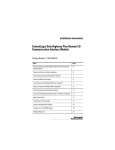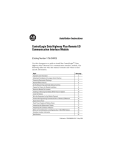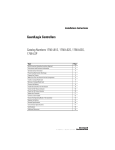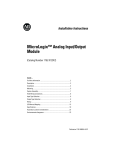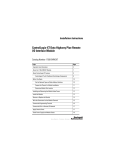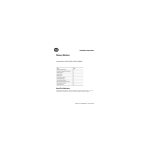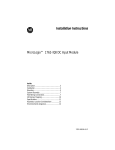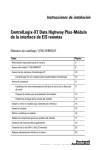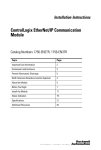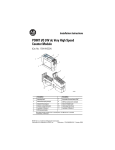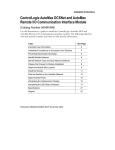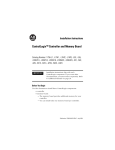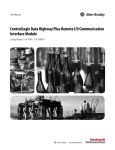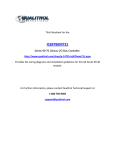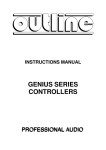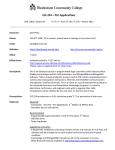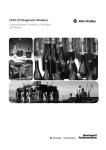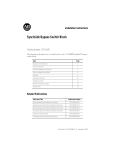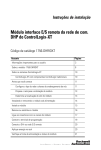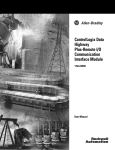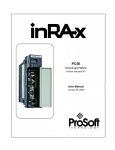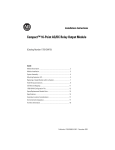Download 1756-IN003B-EN-P, ControlLogix Data Highway Plus
Transcript
Installation Instructions
ControlLogix Data Highway Plus-Remote I/O
Communication Interface Module
Catalog Number 1756-DHRIO
Use this document to install the ControlLogixTM Data Highway
PlusTM-Remote I/O communication interface module.
To
See page
Obtain a User Manual
2
Important User Information
2
Prevent Electrostatic Discharge
6
Identify Module Features
6
Set the Network Type and Node Address Switches
7
Prepare the Chassis for Module Installation
8
Determine Module Slot Location
9
Installing or Removing the Module While Power Is Applied
9
Install the Module
10
Wire the Connectors for the Module Channels
12
Connect the Programming Terminal and DH+ or Remote I/O Network
13
Apply Chassis Power
13
Check Power Supply and Module Status
14
Interpreting the Alphanumeric Display
15
Interpreting the LED Status Indicators
16
Configuring Your 1756-DHRIO Module
17
Hazardous Location information
18
Specifications
19
Publication 1756-IN003B-EN-P - July 2002
File Name:
AB_ControlLogixDataHighway_1756_DHRIO_install_D702
2 ControlLogix Data Highway Plus-Remote I/O Communication Interface Module
Obtain a User Manual
This product also has a user manual (pub. no. 1756-UM514). To view
it, visit www.ab.com/manuals or www.theautomationbookstore.com.
To purchase a manual, you can:
• contact your distributor or Rockwell Automation representative
• visit www.theautomationbookstore.com and place an order
• call 800.963.9548 (USA/Canada) or 001.320.725.1574 (outside
USA/Canada
Change bars are used to indicate information that has changed or
been added since the previous version of these instructions.
Important User Information
Because of the variety of uses for the products described in this
publication, those responsible for the application and use of these
products must satisfy themselves that all necessary steps have been
taken to assure that each application and use meets all performance
and safety requirements, including any applicable laws, regulations,
codes and standards. In no event will Rockwell Automation be
responsible or liable for indirect or consequential damage resulting
from the use or application of these products.
Any illustrations, charts, sample programs, and layout examples
shown in this publication are intended solely for purposes of
example. Since there are many variables and requirements associated
with any particular installation, Rockwell Automation does not
assume responsibility or liability (to include intellectual property
liability) for actual use based upon the examples shown in this
publication.
Allen-Bradley publication SGI-1.1, Safety Guidelines for the
Application, Installation and Maintenance of Solid-State Control
(available from your local Rockwell Automation office), describes
some important differences between solid-state equipment and
electromechanical devices that should be taken into consideration
when applying products such as those described in this publication.
Publication 1756-IN003B-EN-P - July 2002
ControlLogix Data Highway Plus-Remote I/O Communication Interface Module 3
Reproduction of the contents of this copyrighted publication, in
whole or part, without written permission of Rockwell Automation, is
prohibited.
Throughout this publication, notes may be used to make you aware
of safety considerations. The following annotations and their
accompanying statements help you to identify a potential hazard,
avoid a potential hazard, and recognize the consequences of a
potential hazard:
WARNING
!
ATTENTION
!
IMPORTANT
Identifies information about practices or
circumstances that can cause an explosion in a
hazardous environment, which may lead to
personal injury or death, property damage, or
economic loss.
Identifies information about practices or
circumstances that can lead to personal injury or
death, property damage, or economic loss.
Identifies information that is critical for
successful application and understanding of the
product.
Publication 1756-IN003B-EN-P - July 2002
4 ControlLogix Data Highway Plus-Remote I/O Communication Interface Module
Enclosure and Environmental Requirements
ATTENTION
!
This equipment is intended for use in a Pollution
Degree 2 industrial environment, in overvoltage
Category II applications (as defined in IEC
publication 60664-1), at altitudes up to 2000 meters
without derating.
This equipment is considered Group 1, Class A
industrial equipment according to IEC/CISPR
Publication 11. Without appropriate precautions,
there may be potential difficulties ensuring
electromagnetic compatibility in other
environments due to conducted as well as radiated
disturbance.
This equipment is supplied as "open type"
equipment. It must be mounted within an
enclosure that is suitably designed for those
specific environmental conditions that will be
present and appropriately designed to prevent
personal injury resulting from accessibility to live
parts. The interior of the enclosure must be
accessible only by the use of a tool. Subsequent
sections of this publication may contain additional
information regarding specific enclosure type
ratings that are required to comply with certain
product safety certifications.
See NEMA Standards publication 250 and IEC
publication 60529, as applicable, for explanations
of the degrees of protection provided by different
types of enclosure. Also, see the appropriate
sections in this publication, as well as the
Allen-Bradley publication 1770-4.1 ("Industrial
Automation Wiring and Grounding Guidelines"),
for additional installation requirements pertaining
to this equipment.
Publication 1756-IN003B-EN-P - July 2002
ControlLogix Data Highway Plus-Remote I/O Communication Interface Module 5
Zone 2 Certification
IMPORTANT
The following apply to this product’s Zone 2
certification:
• This equipment is not resistant to sunlight or other
sources of UV radiation.
• The secondary of a current transformer shall not be
open-circuited when applied in Class I, Zone 2
environments.
• Equipment of lesser Enclosure Type Rating must be
installed in an enclosure providing at least IP54
protection when applied in Class I, Zone 2
environments.
• This equipment shall be used within its specified
ratings defined by Allen-Bradley.
• Provision shall be made to prevent the rated voltage
from being exceeded by transient disturbances of
more than 40% when applied in Class I, Zone 2
environments.
• This equipment is intended for use in potentially
explosive atmospheres as defined by European
Union Directive 94/9/EC.
The LCIE (Laboratoire Central des Industries
Electriques) certifies that this equipment has been
found to comply with the Essential Health and
Safety Requirements relating to the design and
construction of Category 3 equipment intended for
use in potentially explosive atmospheres, given in
Annex II to this Directive. The examination and test
results are recorded in confidential report No. 28
682 010.
Compliance with the Essential Health and Safety
Requirements has been assured by compliance with
EN 50021 (1999).
Publication 1756-IN003B-EN-P - July 2002
6 ControlLogix Data Highway Plus-Remote I/O Communication Interface Module
Prevent Electrostatic Discharge
ATTENTION
!
This equipment is sensitive to electrostatic discharge,
which can cause internal damage and affect normal
operation. Follow these guidelines when you handle
this equipment:
• Touch a grounded object to discharge potential
static.
• Wear an approved grounding wriststrap.
• Do not touch connectors or pins on component
boards.
• Do not touch circuit components inside the
equipment.
• If available, use a static-safe workstation.
• When not in use, store the equipment in
appropriate static-safe packaging.
Identify Module Features
Refer to the figure below to identify module hardware components.
Network Type Switches
(behind cover)
Backplane
connector
Alphanumeric
Status Indicator
Channel and
Module Status
Indicators
8-pin Mini DIN
Programming
Terminal
Connector
Channel A
connector
Node Address
Switches
(behind cover)
Channel B
connector
43232
Publication 1756-IN003B-EN-P - July 2002
Wiring
Label
ControlLogix Data Highway Plus-Remote I/O Communication Interface Module 7
Set the Network Type and Node Address Switches
Before you install the module, you must set the network type
switches for each channel. If the network type is Data Highway Plus
(DH+), you must also set the node address switches for that channel
to a unique address within the range of 00-77.
IMPORTANT
If your module uses the 230k DH+ network (i.e.
Channel A switch set to 3), Channel B is disabled.
Also, node address switches do not apply if you
are using remote I/O.
Network Type Switches (behind cover)
Example shows channel A set for DH+
and channel B set for RIO.
Refer to the label
for switch settings.
Node Address Switches (behind cover)
Example shows channel A node address
at 10 and channel B node address at 24.
43233
Publication 1756-IN003B-EN-P - July 2002
8 ControlLogix Data Highway Plus-Remote I/O Communication Interface Module
Prepare the Chassis for Module Installation
Before you install the DHRIO module, you must install and connect a
ControlLogix chassis and power supply.
Power
Supply
Chassis
43234
For information on installing these products, refer to the publications
listed in the following table.
Chassis
Type
Series B: 1756-A4, -A7, -A10,
-A13, -A17
Chassis
Installation
Power
Supply
Power Supply
Installation
Pub. No.
1756-IN080
1756-PA72/B
Pub. No.
1756-5.67
1756-PB72/B
1756-PA75/A
1756-PB75/A
Publication 1756-IN003B-EN-P - July 2002
Pub. No.
1756-5.78
ControlLogix Data Highway Plus-Remote I/O Communication Interface Module 9
Determine Module Slot Location
The figure below shows chassis slot numbering in a 4-slot chassis.
Slot 0 is the first slot and is always the leftmost slot in the rack (the
first slot to the right of the power supply). You can use any size
ControlLogix chassis and install the module in any slot. You can also
install multiple 1756-DHRIO modules in the same chassis. You can
install as many modules as your power supply can accommodate
(i.e., number for which the power supply is rated).
Slot 2
Slot 0
Slot 1
Slot 3
Power Supply
Chassis
43235
Installing or Removing the Module While Power Is Applied
You can install or remove the module while chassis power is applied
if you observe the following precautions.
WARNING
!
When you insert or remove the module while
backplane power is on, an electrical arc can
occur. This could cause an explosion in
hazardous location installations. Be sure that
power is removed or the area is nonhazardous
before proceeding.
Repeated electrical arcing causes excessive wear to contacts on both
the module and its mating connector. Worn contacts may create
electrical resistance that can affect module operation.
Publication 1756-IN003B-EN-P - July 2002
10 ControlLogix Data Highway Plus-Remote I/O Communication Interface Module
Install the Module
Do not force the module into the backplane
connector. If you cannot seat the module with
firm pressure, check the alignment. Forcing the
module into the chassis can damage the
backplane connector or the module.
ATTENTION
!
1
Align the circuit board with top and
bottom guides in the chassis.
POWER
Circuit board
2
Slide the module into the chassis.
Make sure the module backplane
connector properly connects to the
chassis backplane.
3
The module is properly installed
when it is flush with the power
supply or other installed modules.
Publication 1756-IN003B-EN-P - July 2002
43236
ControlLogix Data Highway Plus-Remote I/O Communication Interface Module 11
Removing or Replacing the Module (When Applicable)
1
Push on upper and
lower module tabs
to disengage them.
POWER
POWER
2
Slide the module out
of the chassis.
43237
If you are replacing an existing module with an identical one, and
you want to resume identical system operation, you must install the
new module in the same slot.
Publication 1756-IN003B-EN-P - July 2002
12 ControlLogix Data Highway Plus-Remote I/O Communication Interface Module
Wire the Connectors for the Module Channels
Wiring
Label
8-pin mini DIN programming terminal connection
parallel to channel A when channel A is configured
for DH+ communication.
Pin Assignments for Channel A
and B Connectors
DH+
Remote I/O
Pin no:
Desc:
Pin no:
1
Clear
1
Shield
2
Blue
Desc:
Blue
Shield
2
Clear
43238
Channel A and
B connectors
Data Highway +/Remote I/O Communications Connections
WARNING
!
If you connect or disconnect the DH+ or Remote
I/O cable with power applied to this module or
any device on the network, an electrical arc can
occur. This could cause an explosion in
hazardous location installations.
Be sure that power is removed or the area is
nonhazardous before proceeding.
Publication 1756-IN003B-EN-P - July 2002
ControlLogix Data Highway Plus-Remote I/O Communication Interface Module 13
Connect the Programming Terminal and DH+ or Remote I/O Network
POWER
POWER
43239
2
1
Connect the programming terminal to
the 8-pin mini DIN connector.
Connect the DH+ or Remote I/O network to
the channel A or B connector as appropriate.
For hazardous locations, use a 1784-CP13 cable
(or equivalent connector) for the programming
terminal connection.
WARNING
!
Apply Chassis Power
ON
ON
POWER
OFF
POWER
OFF
43240
Publication 1756-IN003B-EN-P - July 2002
14 ControlLogix Data Highway Plus-Remote I/O Communication Interface Module
Check Power Supply and Module Status
Alphanumeric status indicator illuminates and cycles through a
sequence of messages (described in the table on the following page).
H+/RIO
CHA CHB
OK
Module OK status indicator is
solid red, then flashing green.
Power Supply indicator is green.
43241
At powerup the module’s alphanumeric display begins a cycle
through the following sequences.
•
•
•
•
•
•
Channel
Channel
Channel
Channel
Channel
Channel
A
A
A
B
B
B
and the network used for channel A - DH+ or RIO
node address, if used for DH+
status
and the network used for channel B - DH+ or RIO
node address, if used for DH+
status
This sequence runs continuously during normal module operation.
EXAMPLE
For example, if your module uses the following:
• Channel A for DH+ with node address 14
• Channel B for RIO
and the channels are operating properly, you see
the following sequence:
• A DH, A#14, A OK, B IO, SCAN, B OK
Publication 1756-IN003B-EN-P - July 2002
ControlLogix Data Highway Plus-Remote I/O Communication Interface Module 15
Troubleshooting the Power Supply
If the alphanumeric indicator on the 1756-DHRIO module does not
cycle through these messages on powerup, refer to the following
table and to the Troubleshooting section that follows.
If the POWER
indicator is:
Power Supply Status is
Recommended Action:
Off
Not operating.
Turn power switch ON.
Check power wiring connections.
Check fuse.
On
Operating.
None, normal operation.
Interpreting the Alphanumeric Display
Your 1756-DHRIO module displays alphanumeric codes that provide
diagnostic information about your module. The alphanumeric display
flashes the codes at approximately 1 second intervals. The following
table summarizes the codes.
Code
Description
Recommended Action
Data Highway Plus
OFF
LINE
Data Highway Plus link
is in STOP state.
Correct the configuration.
Refer to the 1756-DHRIO User Manual,
publication 1756-UM0514.
DUPL
NODE
Data Highway Plus
Duplicate node address.
Choose another node address and reset
switches.
ONLY
NODE
Only node on Data
Highway Plus link.
Check the cables.
CNFG
FALT
Incorrect DH+ routing
table configuration.
Incorrect Data Highway
object configuration.
Correct the configuration. Refer to the
1756-DHRIO user manual, pub. 1756-UM514
Verify the module is inserted in correct slot.
OK
Normal operation for
that channel.
None.
LINK
OFF
Channel B is disabled
because Channel A is used
for 230k DH+ operation.
None
Publication 1756-IN003B-EN-P - July 2002
16 ControlLogix Data Highway Plus-Remote I/O Communication Interface Module
Code
Description
Recommended Action
MUTE
LINK
No adapters found on
remote I/O.
Add an adapter to the remote I/O network.
RACK
OVER
Rack overlap on remote
I/O.
Reconfigure remote I/O racks.
DUPL
SCAN
Duplicate scanner on
remote I/O.
Check remote I/O adapter settings.
MAX_
DEV_
Maximum devices
exceeded on remote I/O.
Remove devices to meet limitations on
remote I/O network.
CHAT
LINK
Babble detected on
remote I/O.
Check remote I/O device and network
connections.
OFF_
LINE
Not trying to
communicate.
None. Normal state if controller is not
controlling remote I/O.
OK
Normal operation
None.
Remote I/O
Interpreting the LED Status Indicators
The three LED status indicators on the module provide information
about your module and the status of each channel. The following
tables outline the indicator condition and the corresponding status,
and explain what each condition means.
If the Module OK
indicator is:
Module Status
Recommended Action
Off
Not operating.
Apply chassis power.
Verify module is completely inserted
into chassis and backplane.
Green flashing
Operating but not
routing messages and
no controller
transferring I/O.
None, if no messages are actively being
routed through the module and no
controller transferring I/O.
To route messages or transfer I/O, use
module default configuration or
configure module.
Red, then Off
Performing self-test.
None, normal operation.
Publication 1756-IN003B-EN-P - July 2002
ControlLogix Data Highway Plus-Remote I/O Communication Interface Module 17
If the Module OK
indicator is:
Module Status
Recommended Action
Green
Operating and routing
messages.
Verify module configuration.
Red
In major fault
Reboot module. If red reoccurs, then
replace module.
Red flashing
In major fault or
configuration fault.
Check alphanumeric indicator and take
action described in alphanumeric
display message table on page 15.
If the channel
A or B
indicator is:
in this
channel
mode:
then the channel
status is:
take this action:
Off
All
Not on line.
Place channel on line.
Green
RIO scanner
Active RIO link. All
adapter modules are
present and not
faulted.
None, normal operation.
DH+
Operating.
None, normal operation.
RIO scanner
One or more nodes
faulted or failed.
Check power at other racks.
DH+
No other node on the
network.
Check cables.
Red
All
Hardware fault.
Reboot module. If red
reoccurs, replace module.
Red flashing
RIO scanner
Faulted adapters
detected.
Check cables.
Check power at other racks.
DH+
Duplicate node
detected.
Check node address.
Green flashing
Configuring Your 1756-DHRIO Module
After installing your 1756-DHRIO module, you must configure it. For
more information, refer to the Data Highway Plus-Remote I/O
Communication Interface Module User Manual, publication
1756-UM514.
Publication 1756-IN003B-EN-P - July 2002
18 ControlLogix Data Highway Plus-Remote I/O Communication Interface Module
Hazardous Location information
The following information applies when
operating this equipment in hazardous
locations:
Informations sur l’utilisation de cet équipement
en environnements dangereux :
Products marked “CL I, DIV 2, GP A, B, C, D” are
suitable for use in Class I Division 2 Groups A,
B, C, D, Hazardous Locations and nonhazardous
locations only. Each product is supplied with
markings on the rating nameplate indicating the
hazardous location temperature code. When
combining products within a system, the most
adverse temperature code (lowest “T” number)
may be used to help determine the overall
temperature code of the system. Combinations
of equipment in your system are subject to
investigation by the local Authority Having
Jurisdiction at the time of installation.
Les produits marqués "CL I, DIV 2, GP A, B, C, D" ne
conviennent qu’à une utilisation en environnements
de Classe I Division 2 Groupes A, B, C, D dangereux
et non dangereux. Chaque produit est livré avec des
marquages sur sa plaque d’identification qui
indiquent le code de température pour les
environnements dangereux. Lorsque plusieurs
produits sont combinés dans un système, le code de
température le plus défavorable (code de
température le plus faible) peut être utilisé pour
déterminer le code de température global du
système. Les combinaisons d’équipements dans le
système sont sujettes à inspection par les autorités
locales qualifiées au moment de l’installation.
WARNING
!
EXPLOSION HAZARD
• Do not disconnect
equipment unless
power has been
removed or the area
is known to be
nonhazardous.
• Do not disconnect
connections to this
equipment unless
power has been
removed or the area
is known to be
nonhazardous.
Secure any external
connections that
mate to this
equipment by using
screws, sliding
latches, threaded
connectors, or other
means provided
with this product.
• Substitution of
components may
impair suitability for
Class I, Division 2.
• If this product
contains batteries,
they must only be
changed in an area
known to be
nonhazardous.
Publication 1756-IN003B-EN-P - July 2002
AVERTISSEMENT
!
RISQUE D’EXPLOSION
• Couper le courant ou
s’assurer que
l’environnement est
classé non dangereux
avant de débrancher
l'équipement.
• Couper le courant ou
s'assurer que
l’environnement est
classé non dangereux
avant de débrancher
les connecteurs. Fixer
tous les connecteurs
externes reliés à cet
équipement à l'aide
de vis, loquets
coulissants,
connecteurs filetés ou
autres moyens fournis
avec ce produit.
• La substitution de
composants peut
rendre cet
équipement inadapté
à une utilisation en
environnement de
Classe I, Division 2.
• S’assurer que
l’environnement est
classé non dangereux
avant de changer les
piles.
ControlLogix Data Highway Plus-Remote I/O Communication Interface Module 19
Specifications
Module Location
ControlLogix chassis
Maximum Backplane
Current Load
850mA @ +5.1V dc and 1.7mA @ 24 V dc
from I/O chassis backplane
Power Dissipation
4.5W maximum
Thermal Dissipation
15.4 BTU/hr maximum
Available Baud Rates
57.6Kbaud
115.2Kbaud
230.4Kbaud
Environmental Conditions:
Operating
Temperature
IEC 60068-2-1 (Test Ad, Operating Cold),
IEC 60068-2-2 (Test Bd, Operating Dry Heat),
IEC 60068-2-14 (Test Nb, Operating Thermal Shock):
0 to 60°C (32 to 140°F)
Storage
Temperature
IEC 60068-2-1 (Test Ab, Un-packaged Non-operating Cold),
Relative
Humidity
IEC 60068-2-30 (Test Db, Un-packaged Non-operating Damp
Heat):
5 to 95% non-condensing
IEC 60068-2-2 (Test Bb, Un-packaged Non-operating Dry Heat),
IEC 60068-2-14 (Test Na, Un-packaged Non-operating
Thermal Shock):
–40 to 85°C (–40 to 185°F)
Vibration
IEC 60068-2-6 (Test Fc, Operating):
2g @ 10-500Hz
Shock
IEC 60068-2-27 (Test Ea, Unpackaged Shock):
Operating 30g
Non-operating 50g
Emissions
CISPR 11:
Group 1, Class A
ESD Immunity
IEC 61000-4-2:
6kV contact discharges
8kV air discharges
Radiated RF Immunity
IEC 61000-4-3:
10V/m with 1kHz sine-wave 80%AM from 80MHz to
2000MHz
10V/m with 200Hz 50% Pulse 100%AM at 900Mhz
EFT/B Immunity
IEC 61000-4-4:
±2kV at 5kHz on communications ports
Publication 1756-IN003B-EN-P - July 2002
Surge Transient Immunity
IEC 61000-4-5:
+2kV line-earth (CM) on shielded ports
Conducted RF Immunity
IEC 61000-4-6:
3Vrms with 1kHz sine-wave 80%AM from 10kHz to 80MHz
10Vrms with 1kHz sine-wave 80%AM from 150kHz to
80MHz
Enclosure Type Rating
None (open-style)
Screw Terminal Torque
0.5 - 0.6Nm
Conductors:
Belden 9463 twinaxial
20 AWG (0.519mm2)
2(1)
Wire Size
Category
Certifications
(when product is marked)
UL
CSA
CSA
CE(2)
C-Tick(2)
EEx(2)
(1)
(2)
UL Listed Industrial Control Equipment
CSA Certified Process Control Equipment
CSA Certified Process Control Equipment for Class I,
Division 2 Group A,B,C,D Hazardous Locations
European Union 89/336/EEC EMC Directive, compliant
with:
EN 61000-6-4; Industrial Emissions
EN 50082-2; Industrial Immunity
EN 61326; Meas./Control/Lab., Industrial
Requirements
EN 61000-6-2; Industrial Immunity
Australian Radiocommunications Act, compliant with:
AS/NZS 2064; Industrial Emissions
European Union 94/9/EEC ATEX Directive, compliant with:
EN 50021; Potentially Explosive Atmospheres,
Protection “n”
Use this conductor category information for planning conductor routing as described in system level
installation manual. Also refer to 1770-4.1, Industrial Automation Wiring and Grounding Guidelines.
See the Product Certification link at www.ab.com for Declarations of Conformity, Certificates, and
other certification details.
Publication 1756-IN003B-EN-P - July 2002
Supersedes Publication 1756-IN003A-EN-P - May 2001
PN 957678-19
Copyright © 2002 Rockwell Automation. All rights reserved. Printed in the U.S.A.




















